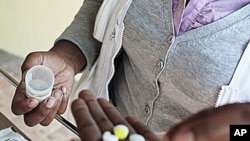A medical aid group says the spread of multi-drug-resistant tuberculosis is much greater than previously thought. Doctors Without Borders calls the situation alarming. MDR-TB is a form of tuberculosis that does not respond to standard treatment and can kill in a matter of months.
“Wherever we’re looking for drug-resistant TB we’re finding it in very alarming numbers. And that suggests to us that the current statistics that are being published about the prevalence of MDR-TB are really just scratching the surface of the problem,” said Dr. Leslie Shanks, medical director for the group, also known as MSF.
MSF has been collecting data from its clinics around the world.
“We have evidence from Asia, Africa, central Asia. Wherever we are working we are finding this problem,” she said.
It’s not just showing up in many places, it’s showing up in large numbers.
“In our program, for example, in the northern part of Uzbekistan we’ve started to test systematically all of our TB patients for drug resistance, whether or not they appear to be at risk for drug resistance. And we’re finding that two-thirds of our patients are MDR, which is just an astounding number,” she said.
Going undetected
The MSF medical director says MDR-TB can go unnoticed during a routine TB exam. Its symptoms are similar to the more common form of TB. Dr. Shanks explained why it’s spread so quickly and so far.
“We know that drug resistance is a man-made problem. It comes from incorrect treatment. It comes from the availability of over-the-counter tuberculosis medications. It comes from patients not taking their drugs properly or drug supplies running out. So they’re not able to finish their treatment. And sometimes it comes from just doctors’ prescribing patterns,” she said.
There’s good reason why patients with MDR-TB would stop taking their medication. They have to swallow about 14 pills daily of highly toxic drugs. Treatment can last up to two years and there are many unpleasant side effects. Plus there are additional injections required. Regular TB treatment has few, if any, side effects and lasts about six months. There are also a lot fewer pills to take.
Out with the old…
Current drugs are many decades old. Shanks says there’s little incentive to discover new TB drugs.
“There’s very little market for this. We’re really pushing now that there is funding for new drug development for clinical trial; and that pharmaceutical companies are working on drug development to address this issue,” she said.
She says without new drugs it will be difficult to deal with the expanding scope of MDR-TB. She adds the disease knows no borders and that developed countries are not immune.








